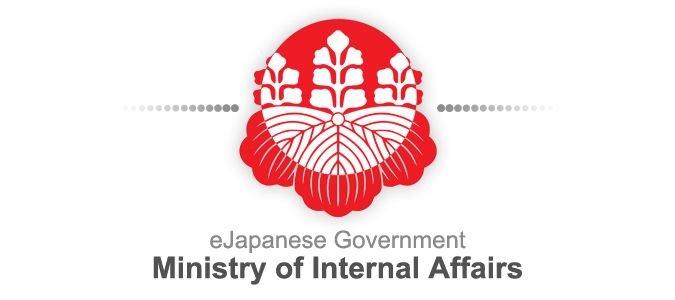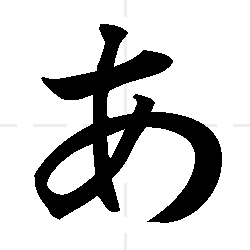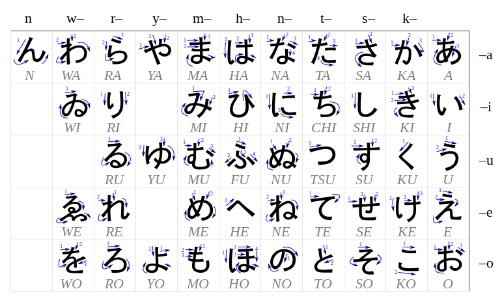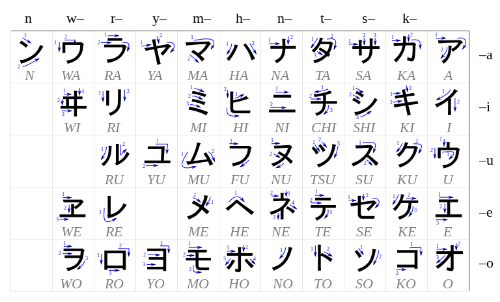[MoIA] Japanese Lessons Pt. 1
 •
by
•
by William of Edenbury

Greetings Ladies and Gentlemen o/
The Ministry of Internal Affairs has been asked to supplement the Ministry of Education's efforts with a series of articles on the Japanese Language. Many of us came to eJapan to have fun learning about Real Life Japan after all so lets get to it!
😃

Well when it comes to learning a new language we all have to start at the same place. And that place is being able to read and make the sounds of the new language's alphabet. The Japanese written language is more than a little foreign to those of us that speak western languages based on the Roman Alphabet.
First off, the Japanese "Alphabet" is divided into three forms.
Hiragana:

This is the basis of being able to pronounce written words in Japanese. A big difference you will notice between Japanese and Roman alphabets when you get down the page is that Japanese largely uses syllables rather than the single sound combinations Latin derived languages use. So to us its not a single letter alphabet but a two letter alphabet. The exception to this "two-letter" rule are the vowels A, I, U, E, O
Katakana:

Similar to hiragana in that it is used to pronounce words, Katakana is more specifically used to pronounce foreign loanwords. That is, words from other languages that have been included into Japanese. Alot of them are based on English, but you will also see plenty of Spanish, Portuguese, and German loanwords among others.
Kanji:

More or less meaning "Chinese Characters", these are the complicated symbols we in the west think of when we imagine Japanese. The reason they are called Chinese characters is because, you guessed it, Kanji are taken from the Chinese "alphabet". This the most difficult category of written Japanese to learn, but also the most often used. There are quite literally thousands of Kanji, but even native born Japanese are not expected to learn all of them. (Some of the Kanji for example refer to complex legal concepts that no one but a lawyer would need to know)
Bonus!
Romanji:

This literally means "Roman Characters". These characters aren't really used normally. The purpose is to help students that use languages based on the Roman alphabet learn Japanese by giving them characters they know how to pronounce already. As you might guess, we will be using Romanji extensively in the upcoming articles
Furigana:

This is the term used for pronunciation aids. These are little characters (Typically Hiragana) that will appear next to kanji or foreign words that help pronounce ambiguous words/Kanji, or anything the reader is not expected to already know.

Now on to the actual Characters!
Hiragana:

Here you have a very handy Image. This shows you the characters, they're Roman Alphabet Pronunciation, and their stroke order. The stroke order may seem unnecessary but it actually helps you draw the character more easily and correctly once you get used to it.
Katakana:

As you can see, the pronunciations are the exact same as the Hiragana, but the characters are completely different. This is helpful in identifying loanwords and figuring out what they mean since many loanwords are from English. タクシ for example is pronounced Takushi and means Taxi.
Kanji:

So as not to overload you with too much information we will show you this one Kanji today. It is written in Hiragana as わたし and Romanji as Watashi. It means "I", or "Myself". If you want to learn Japanese, you will be using this Kanji a lot.
Some Greetings:

I know you guys will be itching to use what you just learned so here are same greeting phrases you can use the above images to pronounce.
おはよう
Good Morning (Casual)
こんにちわ
Good Afternoon
こんばんわ
Good Evening
Note: the ば is pronounced Ba because of those two little extra marks it has. We will cover these extra marks and some letter combinations such as じょう "Jyou" in the next lesson.
Second Note: This is not actually the proper writing for the last two words. Instead of わ the last Hiragana is supposed to be は, but that involves a pronunciation rule/exception that is not covered in this lesson so I left it in the improper form so you can figure out the verbal pronunciation
That's all for now, cya next time o/


Comments
一番目!
keduax!
Actually, correct way to write is 「こんばんは」「こんにちは」 etc. Sometimes Japanese use 「こんばんわ」 etc. because it is cute but this is not the proper way.
Aye, Mii got on to me about that already lol. I'll edit the article and include a note on it. Problem was I couldnt really think of any other simple yet immediately useful words that could be pronounced with just this lesson
v
damn those kanji are rally hard to learn. I know the Kana but the problem is that every kanji has different meaning and can be used in different cases
that is a lot for a lesson 1
I'm going to keep the Hiragana/Katakana tables in most of the articles. It'd be a bit much to expect everyone to immediately memorize the tables. Its more that I want everyone to have some familiarity with the concepts so they aren't surprised when they are brought back up in the next lesson
Interesting read! Thank you
i voted it because this article is awesome
[removed]
v
Very nice..keep it up.
Cool, voted.
Learn Hiragana the Otaku Way:
http://i.imgur.com/L2Rlv63.jpg
Learn Hiragana and Katakana the Otaku Way:
http://i.imgur.com/ii3oCyn.jpg
Very useful to those who wants to learn Japanese 🙂
I want to learn how to say....Run! The monster is attacking the city!
「逃げろ!怪物が都市を攻撃し始めるんだ!」
v+s
Gee William... My brain is full
v+s Hahah! Very nice. I haven't seen these articles in the last 3 years.